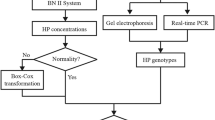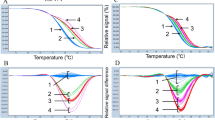Abstract
RECENT reports on the incidence of the serum haptoglobin types of American Indians have included observations on natives of Alaska1, south-western United States2,3, southern Mexico and Guatemala4, Venezuela5, and Chile3. The incidence of the Hp1 gene, shown in Table 1, is usually higher than that found in the population of western Europe4 (gene frequency 0.32–0.43, mean about 0.39). In several tribes, the occurrence of Hp1 is as frequent as that reported in the various Bantus of Africa4 (0.49–0.87). This finding is of particular interest when compared with the low incidence of Hp1 (0.09–0.28) in Asiatic populations2,6. Since genetic drift is often responsible for marked fluctuations in the concentration of given genes in comparatively isolated areas, more observations are necessary to confirm these apparent differences. We have investigated the haptoglobin (and transferrin) types of two Peruvian Indian groups.
This is a preview of subscription content, access via your institution
Access options
Subscribe to this journal
Receive 51 print issues and online access
$199.00 per year
only $3.90 per issue
Buy this article
- Purchase on Springer Link
- Instant access to full article PDF
Prices may be subject to local taxes which are calculated during checkout
Similar content being viewed by others
References
Blumberg, B. S., Allison, A. C., and Garry, B., Ann. Human Genet., 23, 349 (1959).
Sutton, H. E., Neel, J. V., Livingstone, F. B., Benson, G., Kunstadter, P., and Trombley, L. E., Ann. Human Genet., 23, 175 (1959).
Parker, W. C., and Bearn, A. G., Science, 134, 106 (1961).
Sutton, H. E., Matson, G. A., Robinson, A. R., and Koucky, R. W., Amer. J. Human Genet., 12, 338 (1960).
Rodriquez, M. L. G., and Arends, T., Nature, 183, 1465 (1959). Arends, T., and Gallango, M. L., Proc. Eighth Int. Congr. Bl. Trans. (in the press).
Matsunaga, E., and Murai, K., Nature, 186, 320 (1960). Kirk, R. L., Lai, L. Y. C., Mahmood, S., and Singh, R. B., ibid., 185, 185 (1960). Kirk, R. L. (personal communication).
Best, W. R., Clin. Research, 8, 290 (1960).
Layrisse, M., Best, W. R., and Bermejo, R., Amer. J. Phys. Anthrop. (submitted for publication).
Best, W. R., J. Lab. and Clin. Med., 54, 791 (1959).
Smithies, O., Biochem. J., 61, 629 (1955).
Poulik, M. D., Nature, 180, 1477 (1957).
Giblett, E. R., and Steinberg, A. G., Amer. J. Human Genet., 12, 160 (1960).
Giblett, E. R., Nature, 183, 192 (1959).
Giblett, E. R., Hickman, C. G., and Smithies, O., Nature, 183, 1589 (1959).
Author information
Authors and Affiliations
Rights and permissions
About this article
Cite this article
GIBLETT, E., BEST, W. Haptoglobin and Transferrin Types in Peruvian Indians. Nature 192, 1300–1301 (1961). https://doi.org/10.1038/1921300a0
Issue Date:
DOI: https://doi.org/10.1038/1921300a0
This article is cited by
-
Differences between the β-feto-protein of different individuals
Bulletin of Experimental Biology and Medicine (1964)
Comments
By submitting a comment you agree to abide by our Terms and Community Guidelines. If you find something abusive or that does not comply with our terms or guidelines please flag it as inappropriate.



